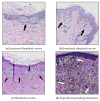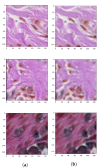Semi-Supervised Nests of Melanocytes Segmentation Method Using Convolutional Autoencoders
- PMID: 32168748
- PMCID: PMC7146382
- DOI: 10.3390/s20061546
Semi-Supervised Nests of Melanocytes Segmentation Method Using Convolutional Autoencoders
Abstract
In this research, we present a semi-supervised segmentation solution using convolutional autoencoders to solve the problem of segmentation tasks having a small number of ground-truth images. We evaluate the proposed deep network architecture for the detection of nests of nevus cells in histopathological images of skin specimens is an important step in dermatopathology. The diagnostic criteria based on the degree of uniformity and symmetry of border irregularities are particularly vital in dermatopathology, in order to distinguish between benign and malignant skin lesions. However, to the best of our knowledge, it is the first described method to segment the nests region. The novelty of our approach is not only the area of research, but, furthermore, we address a problem with a small ground-truth dataset. We propose an effective computer-vision based deep learning tool that can perform the nests segmentation based on an autoencoder architecture with two learning steps. Experimental results verified the effectiveness of the proposed approach and its ability to segment nests areas with Dice similarity coefficient 0.81, sensitivity 0.76, and specificity 0.94, which is a state-of-the-art result.
Keywords: autoencoders; computer vision; deep learning; epidermis; pathology; semi-supervised learning; skin.
Conflict of interest statement
The authors declare no conflict of interest.
Figures











Similar articles
-
Deep Learning Approaches Towards Skin Lesion Segmentation and Classification from Dermoscopic Images - A Review.Curr Med Imaging. 2020;16(5):513-533. doi: 10.2174/1573405615666190129120449. Curr Med Imaging. 2020. PMID: 32484086 Review.
-
Digital hair segmentation using hybrid convolutional and recurrent neural networks architecture.Comput Methods Programs Biomed. 2019 Aug;177:17-30. doi: 10.1016/j.cmpb.2019.05.010. Epub 2019 May 15. Comput Methods Programs Biomed. 2019. PMID: 31319945
-
A Novel Weakly Supervised Multitask Architecture for Retinal Lesions Segmentation on Fundus Images.IEEE Trans Med Imaging. 2019 Oct;38(10):2434-2444. doi: 10.1109/TMI.2019.2906319. Epub 2019 Mar 20. IEEE Trans Med Imaging. 2019. PMID: 30908197
-
Dermoscopic Image Segmentation via Multistage Fully Convolutional Networks.IEEE Trans Biomed Eng. 2017 Sep;64(9):2065-2074. doi: 10.1109/TBME.2017.2712771. Epub 2017 Jun 7. IEEE Trans Biomed Eng. 2017. PMID: 28600236
-
Review of medical image recognition technologies to detect melanomas using neural networks.BMC Bioinformatics. 2020 Sep 14;21(Suppl 11):270. doi: 10.1186/s12859-020-03615-1. BMC Bioinformatics. 2020. PMID: 32921304 Free PMC article. Review.
Cited by
-
Tertiary lymphoid structures (TLS) identification and density assessment on H&E-stained digital slides of lung cancer.PLoS One. 2021 Sep 23;16(9):e0256907. doi: 10.1371/journal.pone.0256907. eCollection 2021. PLoS One. 2021. PMID: 34555057 Free PMC article.
-
Towards Accurate Diagnosis of Skin Lesions Using Feedforward Back Propagation Neural Networks.Diagnostics (Basel). 2021 May 22;11(6):936. doi: 10.3390/diagnostics11060936. Diagnostics (Basel). 2021. PMID: 34067493 Free PMC article.
-
Multiplexed Immunohistochemistry and Digital Pathology as the Foundation for Next-Generation Pathology in Melanoma: Methodological Comparison and Future Clinical Applications.Front Oncol. 2021 Mar 29;11:636681. doi: 10.3389/fonc.2021.636681. eCollection 2021. Front Oncol. 2021. PMID: 33854972 Free PMC article. Review.
-
Automatic Detection Method for Cancer Cell Nucleus Image Based on Deep-Learning Analysis and Color Layer Signature Analysis Algorithm.Sensors (Basel). 2020 Aug 7;20(16):4409. doi: 10.3390/s20164409. Sensors (Basel). 2020. PMID: 32784663 Free PMC article.
-
Automatic Malignant and Benign Skin Cancer Classification Using a Hybrid Deep Learning Approach.Diagnostics (Basel). 2022 Oct 12;12(10):2472. doi: 10.3390/diagnostics12102472. Diagnostics (Basel). 2022. PMID: 36292161 Free PMC article.
References
-
- Lyon: International Agency for Research on Cancer Cancer Incidence in Five Continents Time Trends (Electronic Version) [(accessed on 13 February 2020)]; Available online: http://ci5.iarc.fr.
-
- Cancer Facts & Figures. [(accessed on 13 February 2020)];2016 Available online: http://www.cancer.org/research/cancerfactsstatistics/cancerfactsfigures2....
-
- Australian Bureau of Statistics 3303.0 Causes of Death. [(accessed on 13 February 2020)]; Available online: http://www.abs.gov.au/Causes-of-Death.
-
- Argenziano G., Soyer P.H., Giorgio V.D., Piccolo D., Carli P., Delfino M., Ferrari A., Hofmann-Wellenhof R., Massi D., Mazzocchetti G., et al. Interactive Atlas of Dermoscopy. Edra Medical Publishing and New Media; Milan, Italy: 2000.
MeSH terms
Grants and funding
LinkOut - more resources
Full Text Sources

